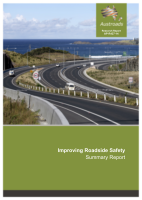Road Design

- Publication no: AP-R437-14
- ISBN: 978-1-925037-48-7
- Published: 12 February 2014
- PDF (free) Download
This report presents road safety engineering practitioners in Australia and New Zealand with updated advice on hazard management, treatment selection and barrier placement in a Safe System context. Roadside hazards pose a major risk to the occupants of vehicles which run off the road. This project investigated the effectiveness of safety barrier selection and placement, providing more forgiving roadside structures (such as frangible poles) or protecting errant vehicles against impacts with them (clear zones). It also investigated the retrofitting of safety barriers to improve motorcyclist safety. The key outcome of the project is a proposed roadside safety management framework focussing on minimising fatal and serious injuries arising from run-off-road crashes.
- 1. Introduction
- 1.1. Aims and Objectives of the Project
- 1.2. Purpose
- 1.3. Project Structure
- 2. Methodology
- 2.1. Literature Review
- 2.2. Site Investigations
- 2.3. Data Analysis
- 2.4. Consultation
- 3. Run-Off-Road Crash Problem in Australia and New Zealand
- 3.1. Incidence and Severity of Run-off-road Crashes
- 3.2. Rural Run-off-road Casualty Crashes
- 4. Towards Safe Roadsides
- 4.1. Safe Roads and Roadsides
- 4.2. Safe Speeds
- 4.3. Safe Vehicles
- 4.4. Safe Road Use
- 4.4.1. Alcohol
- 4.4.2. Fatigue and Drowsiness
- 4.4.3. Distraction/inattention
- 4.4.4. Motorcycling
- 4.5. Steps Towards Safe System Roadsides
- 5. Crash Reduction Effectiveness of Roadside Treatment Options
- 5.1. Mean Speed Change
- 5.2. Provision of Sealed and Unsealed Shoulders
- 5.3. Increasing Clear Zone Widths
- 5.3.1. Rural Clear Zones – Literature Review
- 5.3.2. Urban Clear Zones – Literature Review
- 5.3.3. Rural Clear Zones – Final Analysis of CMFs
- 5.3.4. Selection of CMFs
- 5.4. Roadside Surface Types
- 5.5. Traversable Open Drains
- 5.6. Treatments of Other Drainage Features
- 5.7. Traversable Roadside Slopes
- 5.8. Frangible Poles and Supports
- 5.8.1. Frangible Poles
- 5.8.2. Frangible Sign Posts
- 5.8.3. Underground Utility Services
- 5.9. Reducing Hazard Density
- 5.10. Selection of Vegetation Types
- 5.10.1. Balancing Road Safety and Environmental Impacts
- 5.10.2. Tree Diameter
- 5.10.3. Stage 4 Findings – Vegetation as a Roadside Safety Measure
- 5.11. Treatments for Watercourses, Canals and other Bodies of Water
- 5.12. Safety Barriers in the Safe System
- 5.13. Selection and Placement of Safety Barriers
- 5.13.1. Performance of Different Safety Barrier Types
- 5.13.2. Placement of Safety Barriers – Crash Likelihood
- 5.13.3. Placement of Safety Barriers – Crash Severity
- 5.13.4. Interpretation of Findings
- 5.14. Median Barriers
- 5.15. Barriers for Heavy Vehicles
- 5.16. Motorcyclist Barrier Solutions
- 5.17. Point Hazard Barriers and Attenuators
- 5.18. End Treatments and Transitions
- 5.19. Summary of Treatment Effectiveness
- 6. Severity of Roadside Hazards and Treatment Options
- 6.1. Summary of Findings
- 6.2. FSI Crash Ratios
- 6.3. Interpretation of FSI Crash Ratios
- 6.3.1. Comparison across Road Stereotypes
- 6.3.1. Comparison of Roadside Hazards and Treatment Options across Road Stereotypes
- 6.3.2. Comparison between Jurisdictions
- 7. Proposed Roadside Safety Management Framework
- 7.1. The Proposed Framework
- 7.2. Step 1: Area of Interest Determination
- 7.3. Step 2: Roadside Hazards Identification
- 7.4. Step 3: Treatment Options Identification
- 7.5. Step 4: Severe Injury Risk Evaluation
- 7.5.1. Estimate Mean Run-off-road Casualty Crashes (Collect Data and Apply Models)
- 7.5.2. Apply Crash Modification Factors
- 7.5.3. Estimate Fatal and Serious Injuries
- 7.5.4. Compare Hazard and Treatment Options
- 7.6. Step 5: Safe System Treatment Option Ranking
- 7.7. Step 6: Treatment Design
- 8. Discussion
- 9. Conclusions
- References
- Appendix A Research Findings from the Project
- A.1 Stage 1 (2008–09)
- A.2 Stage 2 (2009–10)
- A.3 Stage 3 (2010–11)
- A.4 Stage 4 (2011–12)
- Appendix B Worked Example of Hazard and Treatment Evaluation
- B.1 Undivided Rural Road Example
- B.2 Divided Rural Road Example
